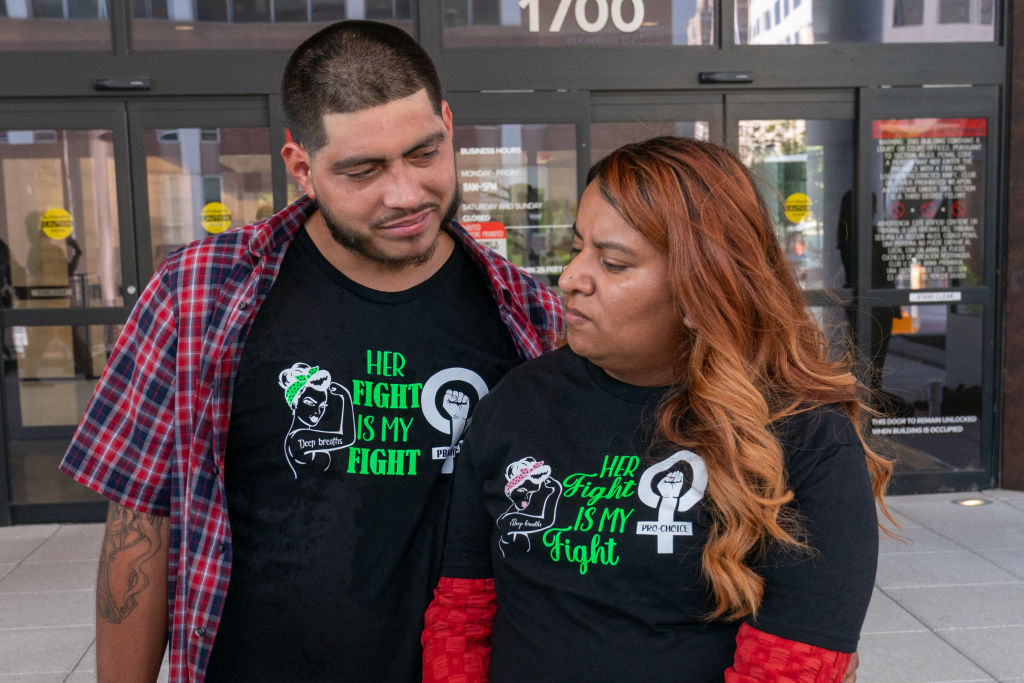
Donald Trump on Monday said he believes abortion should be left to the states. Sidestepping formally endorsing a nationwide ban, the former president’s announcement is already being perceived by some as an attempt to strike a compromise position on a top issue for women voters: A wide majority of Americans support access and believe GOP-imposed bans have gone too far. When it comes to voters, abortion access has proven popular in multiple elections, including in red states where anti-abortion lawmakers have dominated.
Here’s what Trump’s leave-it-to-the-states abortion position would look like in practice—according to anti-abortion leaders, reproductive rights experts, and Trump himself. In short, it leaves women suffering consequences of extreme bans imposed in the wake of the Dobbs decision, and would leave his presidency multiple avenues to highly restrict abortion access nationwide.
1. Many states have already enacted abortion bans and restrictions, and women and doctors are seeking relief from their harms.
Twenty-one states have some ban in effect, and abortion is currently completely illegal in 14 states. The 2020 Turnaway Study, led by Dr. Diana Greene Foster, provides evidence that abortion access strongly enhances women’s health and well-being, whereas denying abortion results in physical and economic harm.
This proliferation of bans means fewer and fewer Americans are able to get abortion care in their own state: According to the Guttmacher Institute’s Monthly Abortion Provision Study, the number of patients traveling to other states to obtain abortion care has doubled in recent years—reaching nearly one in five in the first half of 2023, compared with one in 10 in 2020.
Abortion bans are having a devastating effect on rape survivors who become pregnant, and having to seek abortion care outside of the state adds to the trauma of rape. In the 18 months after the Supreme Court overturned Roe, there were more than 500,000 reported and unreported rapes, resulting in 65,000 rape-related pregnancies. (Of all the states, Texas had the highest number of rape-related pregnancies: 26,313—which was 45 percent of the total rape-related pregnancies in the abortion-ban states evaluated.).
Not only are pregnant women (including thousands of teens) being forced to stay pregnant when they don’t want to be, but some are also being forced to put their physical and mental health in danger to give birth to nonviable fetuses. This is because extreme bans criminalizing abortion have stoked fear and confusion among doctors, who face life in prison, huge fines, civil penalties and loss of their medical licenses for performing abortions, even to save a woman’s life—resulting in pregnant patients facing life-threatening situations being turned away from emergency rooms.

In the wake of the Florida Supreme Court’s greenlighting of a six-week ban in the state last week, President Joe Biden summed up the current abortion landscape: “Women are being turned away from emergency rooms, forced to go to court to seek permission for the medical attention they need, and left to travel hundreds of miles for healthcare.”
Women denied abortions for dangerous pregnancies in Idaho, Oklahoma, Tennessee and Texas—joined by many of their doctors—have brought lawsuits seeking clarification of state laws, with varying success.
Later this month, the Supreme Court will hear another abortion-related case, Idaho v. United States, to decide whether the federal statute Emergency Medical Treatment and Active Labor Act (EMTALA) supersedes state-level abortion bans. “The Biden administration is trying to clarify that the federal law saying doctors have to keep patients not just alive but stable—that doctors have to help patients not just avoid death, but avoid major and potentially irreversible harm—applies fully to pregnant women, too,” Jill Filipovic wrote, summing up the case. “The same Supreme Court that overturned Roe v. Wade will now be asked to answer the question: Are pregnant women full people under the law?” The case is being argued on April 24, with a decision to come likely in June.
2. The Supreme Court could impose a nationwide ban on telemedicine abortion—a critical avenue for abortion access post-Dobbs, especially for people in states banning abortion.
The Court is already considering a Republican challenge to FDA approval of the abortion pill mifepristone.
The case, brought by anti-abortion group Alliance for Hippocratic Medicine and argued last month, attempts to limit access to the abortion pill mifepristone, claiming the pills are dangerous to women and girls. Experts disagree: The procedure successfully terminates a pregnancy 99.6 percent of the time, with a 0.4 percent risk of major complications, and a mortality rate of less than 0.001 percent, according to the FDA. Similarly, the American College of Obstetricians and Gynecologists has found that “major adverse events—significant infection, excessive blood loss, or hospitalization” occur in less than 0.32 percent of patients. A ruling will come this summer.
In 2023, 63 percent of abortions were done with medications—up from 39 percent in 2017.
3. Anti-abortion activists behind Project 2025 have set their sights on the Comstock Act.
Even if the Supreme Court dismisses the mifepristone case, anti-abortion advocates urge the next president to keep up the fight: A recently released detailed policy agenda from Project 2025, a coalition of over 100 right-wing organizations, calls on the next Republican president to direct the FDA to remove the abortion pill mifepristone from the market nationwide. At minimum, Project 2025 directs the next Republican president to “reinstate earlier safety protocols” for mifepristone, including an in-person dispensing requirement which would ban telemedicine abortion.
The anti-abortion movement is also trying to ban abortion nationwide by using the Comstock Act, 19th-century “chastity” laws that ban mailing “obscene” materials. During last month’s oral arguments in FDA v. Alliance for Hippocratic Medicine, at least two justices expressed openness towards using the 1873 law to ban abortion nationwide, which “brings a lurking danger fully out into the open,” warned Ms. contributor Shoshanna Ehrlich, who called Comstock “the anti-abortion movement’s best hope for the implementation of a national abortion ban as congressional action would not be required seeing as the law is still on the books.”
As anti-abortion activists Mark Lee Dickson and Jonathan Mitchell have admitted, the U.S. does “not need a ‘new’ federal abortion ban on the books, because the Comstock Act is a ‘de facto’ abortion ban that would end abortion in every single state in America.”
The law could apply not only to mifepristone, but also to any other medication or instrument used for abortion, thereby not only banning medication abortion but procedural abortion as well.
Jessica Valenti in Abortion, Everyday summed it up like this: “Conservatives’ abortion plan for a second Trump administration has never been reliant on a national ban, because they know they might not be able to get the votes. Instead, the focus is on using control of the FDA and the DOJ to implement backdoor bans. By replacing the head of the FDA, a Trump administration would rescind approval of mifepristone, one of the two medications used to end a pregnancy. … With the DOJ, they’d ensure that the Comstock Act, the 19th-century zombie law that makes it illegal to ship ‘obscene’ materials, would be used to stop the mailing of abortion medication or supplies.”
“Women’s lives put at risk, doctors threatened for doing their job, attacks on birth control, and threats to IVF fertility treatment,” warned Julie Rodriguez, the Biden-Harris campaign manager. “It is a dark preview of what Trump and his Project 2025 extremists will inflict on America.”
4. Trump gave the U.S. the Dobbs Court, despite flip-flopping on abortion over the years.
In October 1999, on NBC’s Meet the Press, Trump said, “I am very pro-choice … in every respect, in as far as it goes.”
In February 2011, he seemed to flip positions. While considering a run for president, Trump declared, “I am pro-life,” speaking in front of the Conservative Political Action Conference.
In February 2016, while formally running for president, Trump doubled down on this anti-abortion stance and urged “some form of punishment” for women who seek abortions.
In October of that same year, Trump vowed to appoint the number of justices necessary to the Supreme Court to overturn Roe. v. Wade—a vision he completed over the next four years: Neil Gorsuch in 2017, Brett Kavanaugh in 2018 and Amy Coney Barrett in 2020.
When Roe was finally overturned in the summer of 2022, Trump took credit for installing the judges on the Court that enabled Dobbs, calling the ruling “the biggest win for life in a generation” and one that was “only made possible because I delivered everything as promised, including nominating and getting three highly respected and strong constitutionalists confirmed to the United States Supreme Court.” He added, “It was my great honor to do so.”
Last month, Trump told advisers and allies that he favors a 16-week national abortion ban, an unnamed source told the New York Times. He reportedly told the source he likes the number 16 because “it’s even. It’s four months.”
No matter what he says, Trump’s actions speak louder than his words. He has appointed people to the Supreme Court who have overturned constitutional abortion rights, his supporters have banned abortion in close to half of states—despite their constituents’ support for abortion rights—and he and his supporters have publicly shared detailed plans to ban abortion nationwide if Republicans regain the White House in January. It’s clear Trump and his supporters will ban abortion nationwide if he is reelected.
Up next:
U.S. democracy is at a dangerous inflection point—from the demise of abortion rights, to a lack of pay equity and parental leave, to skyrocketing maternal mortality, and attacks on trans health. Left unchecked, these crises will lead to wider gaps in political participation and representation. For 50 years, Ms. has been forging feminist journalism—reporting, rebelling and truth-telling from the front-lines, championing the Equal Rights Amendment, and centering the stories of those most impacted. With all that’s at stake for equality, we are redoubling our commitment for the next 50 years. In turn, we need your help, Support Ms. today with a donation—any amount that is meaningful to you. For as little as $5 each month, you’ll receive the print magazine along with our e-newsletters, action alerts, and invitations to Ms. Studios events and podcasts. We are grateful for your loyalty and ferocity.





